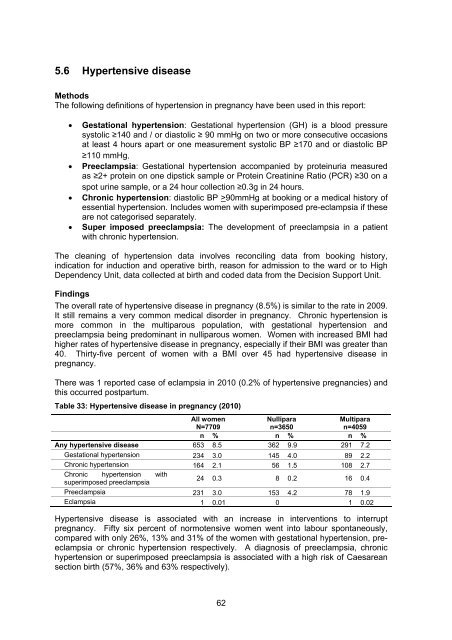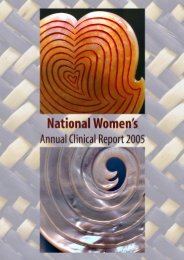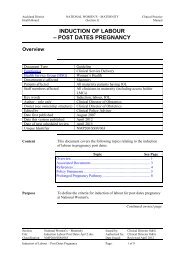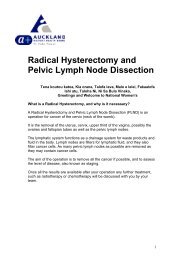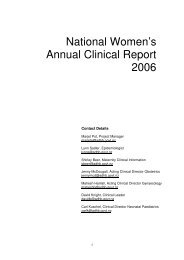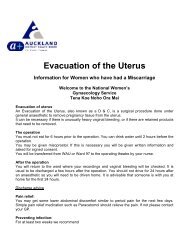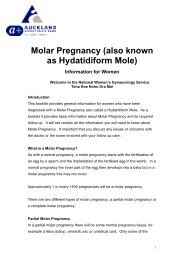National Women's Annual Clinical Report 2010
National Women's Annual Clinical Report 2010
National Women's Annual Clinical Report 2010
Create successful ePaper yourself
Turn your PDF publications into a flip-book with our unique Google optimized e-Paper software.
5.6 Hypertensive disease<br />
Methods<br />
The following definitions of hypertension in pregnancy have been used in this report:<br />
Gestational hypertension: Gestational hypertension (GH) is a blood pressure<br />
systolic ≥140 and / or diastolic ≥ 90 mmHg on two or more consecutive occasions<br />
at least 4 hours apart or one measurement systolic BP ≥170 and or diastolic BP<br />
≥110 mmHg.<br />
Preeclampsia: Gestational hypertension accompanied by proteinuria measured<br />
as ≥2+ protein on one dipstick sample or Protein Creatinine Ratio (PCR) ≥30 on a<br />
spot urine sample, or a 24 hour collection ≥0.3g in 24 hours.<br />
Chronic hypertension: diastolic BP >90mmHg at booking or a medical history of<br />
essential hypertension. Includes women with superimposed pre-eclampsia if these<br />
are not categorised separately.<br />
Super imposed preeclampsia: The development of preeclampsia in a patient<br />
with chronic hypertension.<br />
The cleaning of hypertension data involves reconciling data from booking history,<br />
indication for induction and operative birth, reason for admission to the ward or to High<br />
Dependency Unit, data collected at birth and coded data from the Decision Support Unit.<br />
Findings<br />
The overall rate of hypertensive disease in pregnancy (8.5%) is similar to the rate in 2009.<br />
It still remains a very common medical disorder in pregnancy. Chronic hypertension is<br />
more common in the multiparous population, with gestational hypertension and<br />
preeclampsia being predominant in nulliparous women. Women with increased BMI had<br />
higher rates of hypertensive disease in pregnancy, especially if their BMI was greater than<br />
40. Thirty-five percent of women with a BMI over 45 had hypertensive disease in<br />
pregnancy.<br />
There was 1 reported case of eclampsia in <strong>2010</strong> (0.2% of hypertensive pregnancies) and<br />
this occurred postpartum.<br />
Table 33: Hypertensive disease in pregnancy (<strong>2010</strong>)<br />
All women<br />
Nullipara<br />
Multipara<br />
N=7709<br />
n=3650<br />
n=4059<br />
n % n % n %<br />
Any hypertensive disease 653 8.5 362 9.9 291 7.2<br />
Gestational hypertension 234 3.0 145 4.0 89 2.2<br />
Chronic hypertension 164 2.1 56 1.5 108 2.7<br />
Chronic hypertension<br />
superimposed preeclampsia<br />
with<br />
24 0.3 8 0.2 16 0.4<br />
Preeclampsia 231 3.0 153 4.2 78 1.9<br />
Eclampsia 1 0.01 0 1 0.02<br />
Hypertensive disease is associated with an increase in interventions to interrupt<br />
pregnancy. Fifty six percent of normotensive women went into labour spontaneously,<br />
compared with only 26%, 13% and 31% of the women with gestational hypertension, preeclampsia<br />
or chronic hypertension respectively. A diagnosis of preeclampsia, chronic<br />
hypertension or superimposed preeclampsia is associated with a high risk of Caesarean<br />
section birth (57%, 36% and 63% respectively).<br />
62


